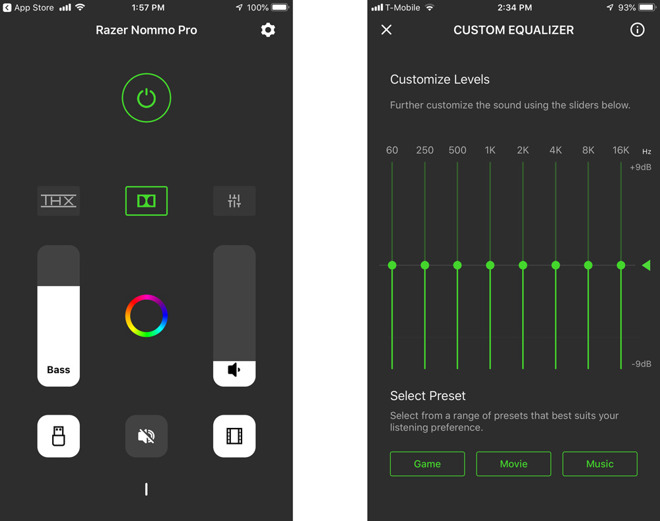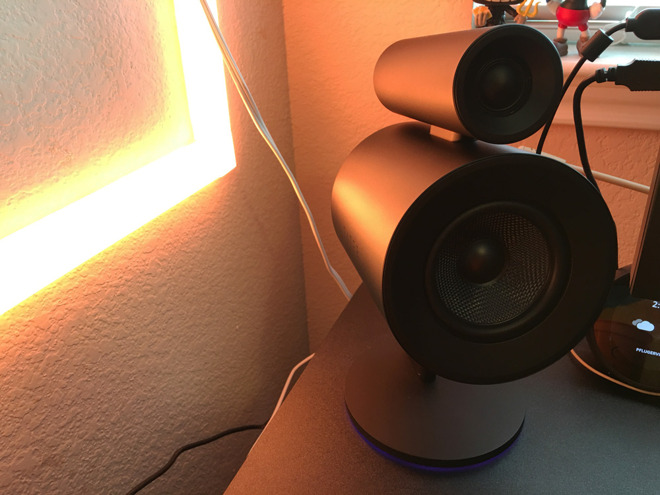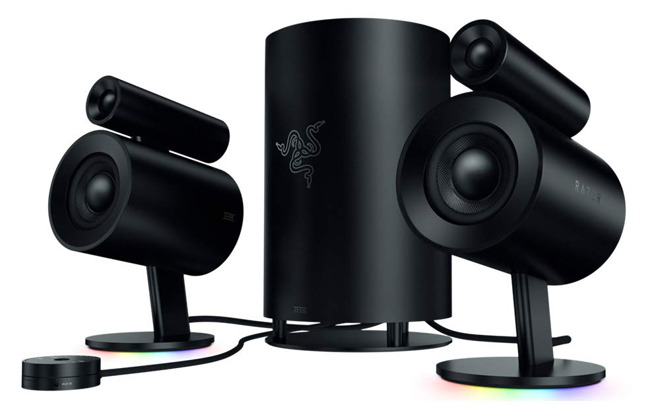Hands on: Razer's Nommo Pro 2.1 speakers for Mac & Windows
Continuing our look at some of the Mac desktop speaker options out there, we're turning to the Razer Nommo Pro -- probably one of the most powerful choices short of ones that won't fit on a desk.
Razer isn't known for its subtlety, often conjuring up images of wildly flashing lights and its iconic graphic logo, which seemingly belongs on the cover on a '90s prog-metal album.
The company has occasionally tried to adopt a more refined style in recent times, and in some ways the Nommo Pro exemplifies this. Its satellites occupy a minimal footprint, use text logos, and limit color effects to the base.
"Minimal" is a relative term however. Those satellites still occupy plenty of vertical space, and the Pro's cylindrical subwoofer is one of the largest I've seen for any home system, on computers or otherwise. It's hard to overstate how gigantic it is -- it's bigger than some mid-tower PCs.
The benefit of course is that the Pro is absurdly powerful. It has a frequency response between 35 hertz and 20 kilohertz, and if you crank up the bass, it will shake any room you could possibly want. Apartment dwellers might as well skip it unless they're on the ground floor.
Connection options include USB, optical, 3.5mm, and Bluetooth 4.2. You'll want to connect via USB if at all possible, since that enables control via Razer's Synapse app. Note however that only Windows users have any serious desktop control by way Synapse 3, which has yet to be ported to macOS. If you're on a Mac, you're stuck with Synapse 2.
The good news is that there's a Nommo Pro iPhone app, which connects via Bluetooth. This lets you tweak volume and bass levels, adjust lighting, change sources, and switch between THX, Dolby, and custom EQ settings. There are even multiple Dolby presets for music, movies, and games.

There'll be plenty more to say in our full review, but for now I'll say that the Pro is the best-sounding system I've ever sat in front of my computer. Imagine having Sonos Ones and a Sub sitting inches away and you can begin to imagine how good it is, whether you're listening to ambient, folk, classical, or metal.
Razer isn't known for its subtlety, often conjuring up images of wildly flashing lights and its iconic graphic logo, which seemingly belongs on the cover on a '90s prog-metal album.
The company has occasionally tried to adopt a more refined style in recent times, and in some ways the Nommo Pro exemplifies this. Its satellites occupy a minimal footprint, use text logos, and limit color effects to the base.
"Minimal" is a relative term however. Those satellites still occupy plenty of vertical space, and the Pro's cylindrical subwoofer is one of the largest I've seen for any home system, on computers or otherwise. It's hard to overstate how gigantic it is -- it's bigger than some mid-tower PCs.
The benefit of course is that the Pro is absurdly powerful. It has a frequency response between 35 hertz and 20 kilohertz, and if you crank up the bass, it will shake any room you could possibly want. Apartment dwellers might as well skip it unless they're on the ground floor.
Connection options include USB, optical, 3.5mm, and Bluetooth 4.2. You'll want to connect via USB if at all possible, since that enables control via Razer's Synapse app. Note however that only Windows users have any serious desktop control by way Synapse 3, which has yet to be ported to macOS. If you're on a Mac, you're stuck with Synapse 2.
The good news is that there's a Nommo Pro iPhone app, which connects via Bluetooth. This lets you tweak volume and bass levels, adjust lighting, change sources, and switch between THX, Dolby, and custom EQ settings. There are even multiple Dolby presets for music, movies, and games.

There'll be plenty more to say in our full review, but for now I'll say that the Pro is the best-sounding system I've ever sat in front of my computer. Imagine having Sonos Ones and a Sub sitting inches away and you can begin to imagine how good it is, whether you're listening to ambient, folk, classical, or metal.



Comments
And it’s not so much that we can’t “hear” below 20 Hz but that we cease to perceive pitch below that, and hear it as simply a rumble. But like any speakers, there’s a “roll-off” taking place with regard to that perception. Play a chord in the bottom octave of the piano and very few people will be able to discern whether it’s major or minor (I’ve only ever encountered one person who could, and he’s a professional pianist and composer, who at the time he could do it was in his early 20s). Do the same in the middle of the piano and everyone can hear the difference.
And you still didn't respond with what 'cheap ass' 15yro speakers go down to 20 (I assume that 20Hz) and what Nokia headphones go to 18Hz. Or is that as assumption on your part because you perceive a rumble?
Before giving your examples any credence, I'd prefer to see reviews with official scientific testing of your specific model done in an anechoic chamber as a baseline. What were those models again?
It seems to be almost axiomatic the first post to almost every AI article is made to criticize, bag on, and dismiss it.
Well, excuse the fuck out of me for not lurking on the board just waiting for you to challenge me so I can respond right away...
I have no idea what brand the cheap ass speakers are. They came in a white box, that I bought at some show somewhere. The spec sheet for them said 20 Hz though. And yes, I do remember, because I wouldn't have bought them if they didn't go at least that low.
As for the Nokia headset, I read it wrong, my Nokia BH-905i goes to 15Hz, not 18.
So you have a manufacturer's spec sheet(s) providing you the frequency response. Truly impeachable sources. I'm sure those extra 3Hz come in handy.
It really doesn't matter of course but since you brought it up, no I do not excuse the fuck out of you. You made a claim which didn't sound (LOL) credible on its face and the more you said the more of a knob you seemed. So far that hasn't changed, though Nokia might have merit your claim.
Now I'm off to order my own white box speakers from Cheap Ass. I'm sure someone will be able to provide a pair with a spec sheet stating 10-30KHz +/– .25dB. I'm diggin' this high-end audio thing. Outside of some misplaced oneupmanship, this none of this means anything in the scheme of things.